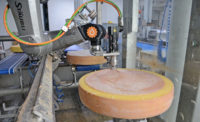Curds and weigh
Cheese company upgrades to flexible weighing and labeling equipment
Packaging as many as 20 different cheese items and sizes each day, Laubscher needed equipment that would upgrade its processes and improve its record keeping.

Laubscher Cheese Co. can process boxes faster with a new scale from Fairbanks. Given the cheese company's need for speed, this feature was extremely important.

With the data entry program, Laubscher Cheese Co. can add new product codes to the Fairbanks Scale any time the need arises. This proves beneficial when a customer requiests an odd pack size or one-time item as soon as possible

Fairbanks installed the system in a networked configuration. The FB3000 instrument with LabelBank software was installed on the production floor and the DataBank server software was installed in their front office. This allows Laubscher to see the data from the production floor as soon as a box was labeled, providing immediate information of what is being produced in the packaging process. Shown is the software user interface
Looking for a reprint of this article?
From high-res PDFs to custom plaques, order your copy today!








